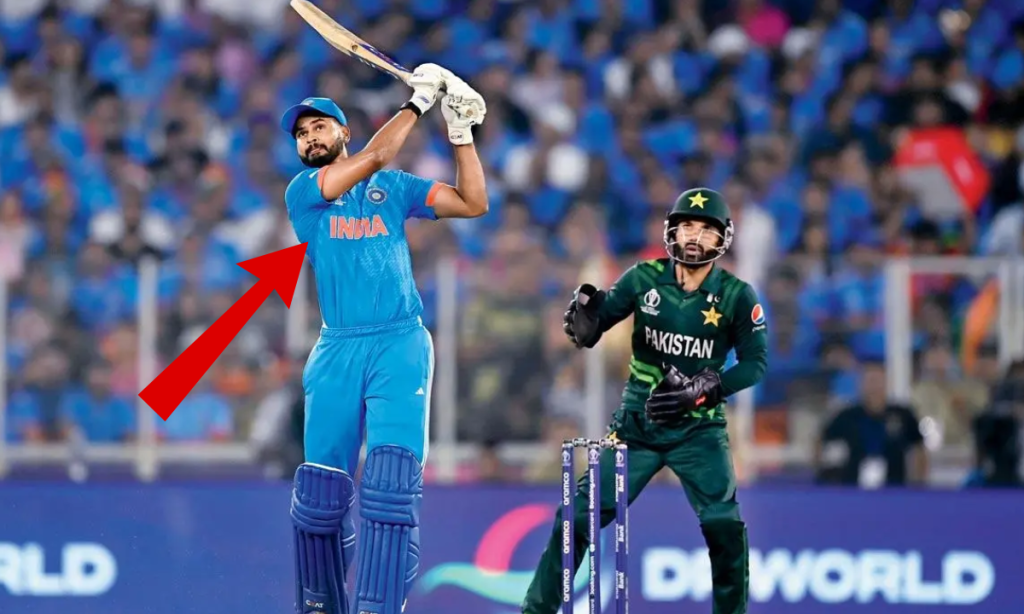In the high-stakes world of international cricket, every player’s technique is scrutinized, and every weakness is exploited.
Shreyas Iyer, India’s stalwart at the number four position in ODIs, has recently come under the spotlight not for his runs but for a specific vulnerability in his game.
This critique comes from none other than former Pakistan cricketer Basit Ali, who has observed Iyer’s recent performances in domestic cricket, particularly during the MUM vs J&K Ranji Trophy match.
Iyer, who is known for his elegant stroke play and has been a pivotal part of India’s lineup, especially in the 2023 ODI World Cup where he amassed 530 runs, had a less than stellar performance in this particular Ranji match.
Scoring just 11 and 17 in both innings, Iyer seemed out of touch, and Ali was quick to point out a significant flaw in his approach.
How To Get Shreyas Iyer’s Wicket
“The worst shot in that innings was of Shreyas Iyer,” Ali commented. He elaborated that with the mid-on fielder pushed back due to six wickets down, Iyer chose to play a shot that was predictably going straight to the fielder.
“The easiest way to dismiss Shreyas Iyer in the Champions Trophy is to have the mid-on back because he is surely going to go for a big hit,” Ali suggested.
This observation is not just a critique but a tactical note for opposing teams preparing to face India in the upcoming ICC Champions Trophy.
As Iyer prepares to return to the international arena in the Champions Trophy, which kicks off on February 19 with India facing Bangladesh on February 20, the spotlight on his shot selection becomes even more intense.
His role in the team is undeniably crucial.
With his average of 66.25 and a strike rate of 113.25 from the 2023 World Cup, Iyer has proven his mettle on the big stage.
However, the recent domestic performance has raised questions about his consistency and adaptability.
Ali’s comments highlight a common strategy in cricket where bowlers and field placements are adjusted to exploit a batsman’s known weaknesses.
For Iyer, it seems, the challenge will be in not just recognizing these setups but also in countering them effectively.
The lure of going for a big hit, especially when the pressure mounts, can often lead to a player’s downfall, and Ali’s advice to teams is to capitalize on this very tendency.
The Champions Trophy, with its format of group stages followed by knockouts, will test Iyer’s ability to adapt.
The conditions in Dubai, where India will play their matches, might be different from those he faced in the Ranji Trophy, but the principle remains the same.
Bowlers will look to exploit any sign of weakness, and Iyer will need to be at his tactical best to avoid falling into traps set by his reputation.
Moreover, Iyer’s journey through domestic cricket has been one of resilience and growth.
His scores in the Vijay Hazare Trophy, where he has been in scintillating form, show that he can bounce back.
Yet, international cricket is a different beast, where every game can define a career, especially in a tournament like the Champions Trophy, which is seen as a mini-World Cup due to its prestigious nature and competitive field.
The narrative around Iyer’s performance is not just about individual matches but about his ability to evolve as a player.
His domestic form, while commendable, needs to translate into international success, particularly with the eyes of the world on him.
The mental aspect of the game, where players must read the field, the bowler, and their own tendencies, will be key. Ali’s commentary serves as both a warning and a roadmap for Iyer to navigate through the scrutiny and adjust his game plan.
As India prepares for the Champions Trophy, the team’s strategy will likely involve protecting Iyer from his known vulnerabilities.
Whether it’s through coaching, personal reflection, or on-the-spot decision-making during matches, Iyer will need to adapt.
The strength of any cricketer lies not only in their technical skills but also in their ability to read the game and make intelligent choices under pressure.
The cricketing world eagerly awaits how Iyer will respond to this critique.
Will he alter his approach at the crease, or will he stick to his guns, believing in the aggressive play that has brought him success? The coming matches will tell, but one thing is clear:
Shreyas Iyer’s performance in the Champions Trophy will be a testament to his growth as one of India’s premier ODI batsmen.
Basit Ali’s insights, while critical, serve as a reminder of the fine margins in cricket where a single shot can define a match or even a tournament.
For Shreyas Iyer, the Champions Trophy is not just another tournament but a stage to silence critics and reaffirm his place as a key component in India’s quest for international glory.
How he navigates this challenge will be a fascinating subplot in the narrative of this cricketing spectacle.

